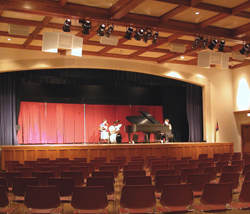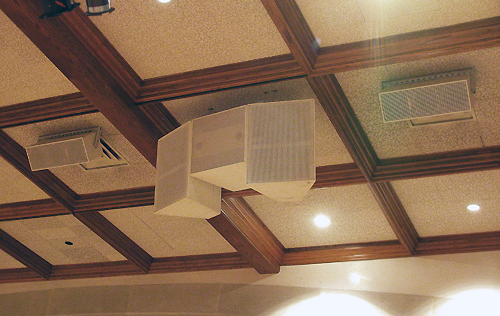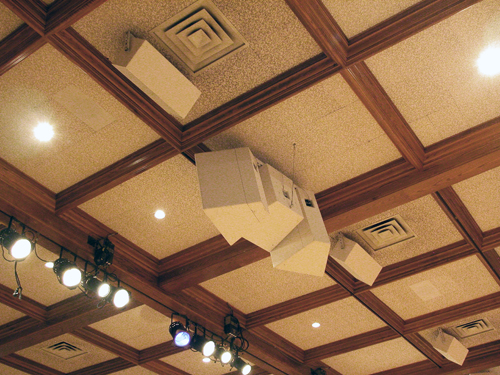
Stereo Imaging
The main loudspeakers were selected and positioned after extensive computer modeling and several site evaluations by Elwell.
While the width of the room and its various applications might have dictated a left-center-right loudspeaker cluster layout, the approach couldn’t be pursued due to a large video screen located where the center cluster would go.
At the same time, the use of left and right main clusters still delivers a stereo image to the vast majority of the audience area.
“The loudspeaker portion of the project was extremely influenced by ceiling height,” Elwell explains. “And, a prerequisite of our designs is selection of loudspeakers with very tight pattern control. These two factors drove our decision, and choices were quite limited.”
Enter EAW’s MQM Series, a smaller derivative of the MQ Series devised for fixed installations. “We took a look at the polars, as well as the size and dimensions of the cabinets, and determined that they would be an appropriate choice,” Elwell adds.
The MQM Series was created specifically for situations where full-range output and tight pattern control are necessary from a compact package. They can be run in passive mode or biamplified, the latter the choice on this project due to adequate number of amplification channels combined with plenty of DSP capability for optimum tailoring.
In both clusters, dual MQM1394e (90-degrees by 40 degrees coverage pattern) loudspeakers combine to cover the rear two-thirds of the room.
.
Each pair flanks a single EAW AS422e (dual 12-in loaded) subwoofer that centers the cluster structures. The dipole pattern control inherent in these subs helps keep the spill of low-frequency energy on to the stage at a minimum.
The remaining front third of the room receives coverage from EAW UB82 compact full-range loudspeakers mounted left and right, firing downward.
These loudspeakers can be muted when the orchestra lift extends the stage, preventing feedback problems that could arise with open microphones in this region.
“Given the low ceiling in relation to the distances we needed to cover, this design using low-profile loudspeakers has worked out very well,” Elwell says. “The impact on the architecture is minimal, and there is no disruptions of sightlines.
“And the multizone approach, allowing the front-covering loudspeakers to be turned off when needed, increases flexibility.”
“The loudspeaker positioning is excellent,” Robinson adds. “Almost anywhere in the room, you get the sense of a stereo image. And coverage is very cohesive front to back, and side to side. This was optimized fully with processing during the tuning process.”
.
The ceiling structure presented a big challenge to the Sound Reinforcements, Inc. installation crew.
Specifically, the difficulty lay in finding solid points from which to rig the clusters without impacting overall structural integrity.
Unistrut was used to fabricate support mechanisms between beams, providing safe, secure flypoints above ceiling level that was certified by a structural engineer.


